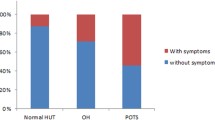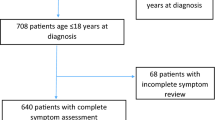Abstract
We examined 51 children and adolescents with orthostatic symptoms using two orthostatic tests, the active standing test (the AS test) and head-up tilt test (HUT), and compared circulatory responses, autonomic function in addition to the induction rate of syncope during short-time orthostasis. Syncope was induced in eight patients with both tests, in only six patients with the AS test and in only one patient with HUT. The induction rate was significantly higher with the AS test (p<0.0001). In addition, the AS test is common and daily postural motion and does not require a tilt table. We calculated percent changes in systolic blood pressure at the initial drop (ΔID-SBP), in systolic blood pressure (ΔSBP), in diastolic blood pressure (ΔDBP), in heart rate (ΔHR), component coefficient variation LF/HF (ΔLF/HF) from supine to upright. ΔHR were significantly larger in fainters than in non-fainters with both tests, although there was no difference in ΔSBP and in ΔDBP. In six fainters only with the AS test, ΔHR was significantly larger with the AS test than with HUT. With the AS test ΔID-SBP were correlative with ΔLF/HF, and ΔLF/HF were correlative with ΔHR, whereas these relations were not clear in HUT. These results indicated the AS test caused cardiac sympathetic activation associated with an initial pressure drop, and was more prone to induce syncope with a greater HR increase in some patients. We conclude the AS test is as potential as HUT as a diagnostic test for syncope.
Similar content being viewed by others
References
Abe T (1986) Japanese Journal of Pediatric Medicine 18:939–943
Alehan D, Celiker A, Ozme S (1996) Head-up tilt test: a high sensitive, specific test for children with unexplained syncope. Pediatr Cardiol 17(2):86–90
Alehan D, Lenk M, Ozme S, et al. (1997) Comparison of sensitivity and specificity of tilt protocols with and without isoproterenol in children with unexplained syncope. Pacing Clin Electrophysiol 20(7):1769–1776
Alehan D, Uner A, Ayabakan C, et al. (2003) Reproducibility of the head-uptilt test results in children with vasovagal syncope. Int J Cardiol 88(1):19–25
Almquist A, Goldenberg IF, Milstein S, et al. (1989) Provocation of bradycardia and hypotension by isoproterenol and upright posture in patients with unexplained syncope. N Engl J Med 320:346–351
Balaji S, Oslizlok PC, Allen MC, et al. (1994) Neurocardiogenic syncope in children with a normal heart. J Am Coll Cardiol 23:779–785
Brignole M, Alboni P, Benditt D, et al. (2001) Task Force on Syncope, European Society of Cardiology.Guidelines on management (diagnosis and treatment) of syncope. Eur Heart J 22(15):1256–1306
Chen XC, Chen MY, Remole S, et al. (1992) Reproducibility of head-up tilttable testing for eliciting susceptibility to neurally mediated syncope in patients without structural heart disease. Am J Cardiol 69:755–756
Dambrink JH, Imholz BP, Karemaker JM, et al. (1991) Postural dizziness and transient hypotension in two healthy teenagers. Clin Auton Res 1(4):281–287
de Jong-de Vos van Steenwijk CCE, Wieling W, Johannes JM, et al. (1995) Incidence and hemodynamic characteristics of near-fainting in healthy 6-to 16-year-old subjects. J Am Coll Cardiol 25:1615–1621
Ericson MO, Lindblad LE (1991) Microcomputer based system for R-R interval detection and autoregressive spectral analysis of variability in biological signals. Technical report. Royal Institute of Technology. Stockholm, ISRN KHT/AVF/FR-91/11-SE
Ganzeboom KS, Colman N, Reitsma JB, et al. (2003) Prevalence and triggers of syncope in medical students. Am J Cardiol 91:1006–1008
Hayano J, Sakakibara Y, Yamada M, et al. (1990) Diurnal variations in vagal and sympathetic cardiac control. Am J Physiol 258:H642–H646
Honda K, Nose T, Yoshida N, et al. (1997) Responses to the postural change and orthostatic dysregulation symptoms. Jpn Circ J 41:629–641
Kaufmann H, Hainsworth R (2001) Why do we faint? Muscle & Nerve 24:981–983
Morillo CA, Klein GJ, Zandri S, et al. (1995) Diagnostic accuracy of a lowdose isoproterenol head-up tilt protocol. Am Heart J 129:901–906
Murdoch BD (1980) Loss of consciousness in healthy South African men: incidence, causes and relationship to EEG abnormality. S Afr Med J 57:771–774
Nakagawa H, Kobayashi Y, Kikushima S, et al. (1998) Long-term effects of pharmacological therapy for vasovagal syncope on the basis of reproducibility during head-up tilt testing. Jpn Circ J 62:727–732
Ross BA, Hugher S, Anderson E, et al. (1991) Abnormal response to orthostatic testing in children and adolescents with recurrent unexplained syncope. Am Heart J 122:748–754
Ruckman RN (1987) Cardiac causes of syncope. Pediatr Rev 9(4):101–108
Shichiri M, Tanaka H, Takaya R, et al. (2000) Efficacy of high sodium intake in a boy with instantaneous orthostatic hypotension. Clin Auton Res 12:47–50
Spranger RJH, Wesseling KH, Imholz ALT, et al. (1991) Initial blood pressure fall on stand up and exercise explained by changes in total peripheral resistance. J Appl Physiol 70:523–553
Stewart JM, Weldon A (2001) Inappropriate early hypotension in adolescents: a form of chronic orthostatic intolerance with defective dependent vasoconstriction. Pediatr Res 50:97–103
Sung RY, Yu CW, Ng E, et al. (2000) Head-up tilt test without intravascular cannulation in children and adolescents. Arch Dis Child 82:154–158
Tanaka H, Sjoeberg BJ, Thulesius O (1996) Cardiac output and blood pressure during active and passive standing. Clin physiol 16(2):157–170
Tanaka H, Thulesius O, Yamaguchi H, et al. (1994) Circulatory response in children with unexpected syncope evaluated by continuous non-invasive finger blood pressure monitoring. Acta Paediatr 83:754–761
Tanaka H, Yamaguchi H, Kim Y, et al. (1993) Instantaneous reduction of blood pressure on standing up in children with psychosomatic symptoms. Acta Paediatr Jpn 97:200–208
Tanaka H, Yamaguchi H, Matsushima R, et al. (1999) Instantaneous orthostatic hypotension in children and adolescents: a new entity of orthostatic intolerance. Pediatr Res 46:691–696
Tanaka H, Yamaguchi H, Tamai H, et al. (1997) Haemodynamic change during vasodepressor syncope in children and autonomic function. Clin Physiol 17:121–133
Wieling W, Harms MP, ten Harkel AD, van Lieshout JJ, Sprangers RL (1996) Circulatory response evoked by a 3 s bout of dynamic leg exercise in humans. J Physiol 494:601–611
Wieling W (1988) Standing, orthostatic stress and autonomic function. In: Bannister R (ed) Autonomic Failure. A textbook of clinical disorders of the autonomic nervous system. 2nd ed. Oxford: Oxford University Press, pp 308–320
Yamaguchi H, Tanaka H, Adachi K, et al. (1996) Beat-to-beat blood pressure and heart rate response to active standing in Japanese children. Acta Paediatr 85:577–583
Author information
Authors and Affiliations
Corresponding author
Rights and permissions
About this article
Cite this article
Matsushima, R., Tanaka, H. & Tamai, H. Comparison of the active standing test and head-up tilt test for diagnosis of syncope in childhood and adolescence. Clin Auton Res 14, 376–384 (2004). https://doi.org/10.1007/s10286-004-0182-2
Received:
Revised:
Issue Date:
DOI: https://doi.org/10.1007/s10286-004-0182-2




